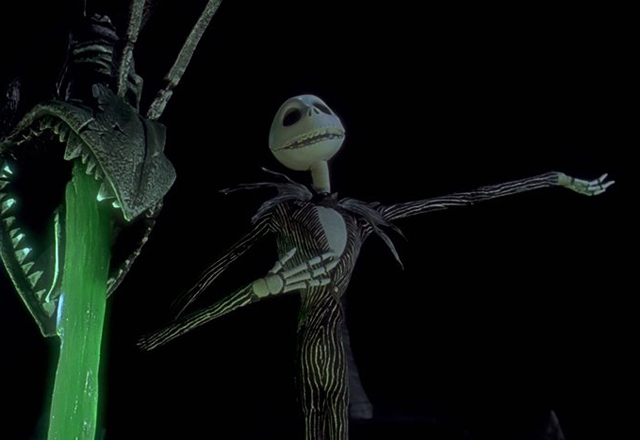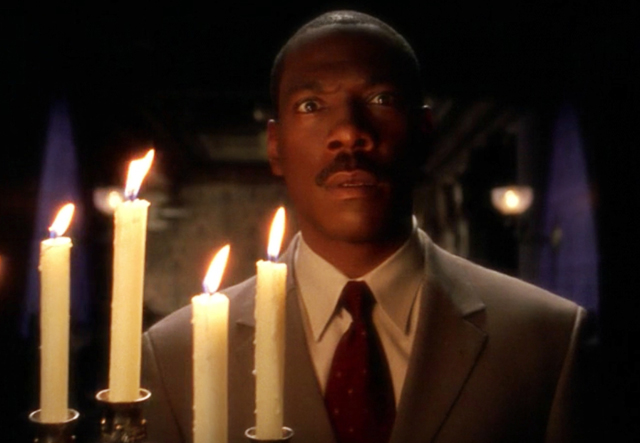
One thing that has been the hallmark of the success of Disney Animation are the characters. Over their 100 years, the studio has grown it’s roster to include hundreds of classic characters that have found their place in the hearts of generations of fans, from Mickey Mouse onward. And while there are groupings of characters that standout more than others, I think that the most surprising fanbase to have popped up over the years has been the ones for the Disney Villains. The Villains sometimes have even been the main attraction, remembered far more than the rest of the films they inhabit, and that’s perhaps because just by their very nature they are out-sized personalities that command every moment they are on screen. In addition to being scene-stealing presences in their movies, the Disney Villains also can become more legendary by just how big of an exit they are given. Because Disney has catered to a family friendly audience for most of it’s existence, they often shy away from violent imagery, and that’s largely the reason why they rarely enact violent ends for their villains. Most of the time the villain receives their comeuppance through karmic retribution or ending up in prison for their crimes. But, there are villains whose evil deeds are so great that a violent end does justify itself. And in some cases, Disney says farewell to their villains in a surprisingly dark and graphic way; by their standards anyway. With Halloween around the corner, and continuing on my look at Disney during their 100th anniversary, I decided to list what I think are the most gruesome villain death scenes from Disney movies. I’m excluding their entirely live action films, so no Star Wars or Marvel since they could fill their own lists, but I will include villain deaths from films that have both live action and animation, as well as include films from Pixar Animation as well. So, here are my picks for the Top Ten Most Gruesome Disney Villain Deaths.
10.
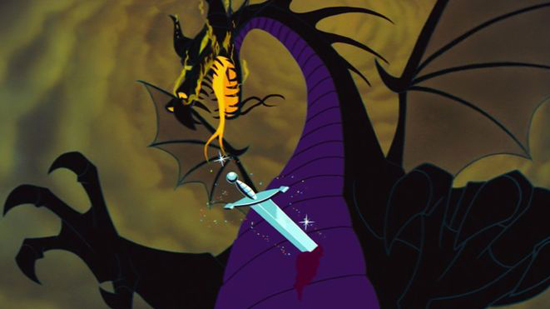
MALEFICENT from SLEEPING BEAUTY (1959)
SLAYED BY AN ENCHANTED SWORD
Certainly the “Mistress of All Evil” would have a death scene that was iconic in it’s own way. The reason I don’t have her higher is because the thing that ultimately dooms her is nothing extraordinary with regard to fantasy storytelling. The valiant Prince Phillip does exactly what any hero in a fairy tale does; he saves the kingdom by slaying a dragon. Perhaps what makes the scene so iconic is not the kill shot, as much of a bullseye as it is, but the whole scene that leads up to it. Maleficent calls upon all of her magical tricks to prevent Phillip from breaking her curse on the kingdom, in a tour de force sequence that shows Disney at it’s absolute best. However, it is when she transforms into a dragon that the scene reaches another level. You really feels the odds stacked up against the hero, with the villain seeming to be unstoppable. And that’s what makes the defeat of Maleficent all the more satisfying by the end, because it all feels like a great evil has been vanquished. The only downside is that the actual plunge of the sword into Maleficent’s heart comes at us a tad bit anti-climatic, though it is significant in the fact that we see a rare instance of on-screen spilled blood in a Walt era Disney movie. It is still a strong moment in the movie, with Maleficent’s pained scream, even in her dragon form, feeling like the roar of an otherworldly demon. Of course, even as the life goes out of her, Maleficent still attempts one final kill as she snaps at Phillip one final time before falling to the ground. It’s not the most creative way for a Disney villain to go out, but the sequence it’s a part of is still an all-time masterwork of animation, and that certainly earns a place for it on this list.
9.
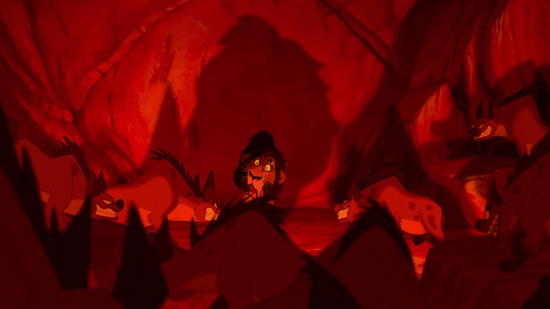
SCAR from THE LION KING (1994)
EATEN ALIVE BY HIS OWN MINIONS
Scar is an interesting case of a villain who succumbed to the consequences of his own misdeeds. His whole evil scheme was to take power through the regicide of his brother the king and his nephew. To do so, he made a pact with the hyenas, giving them free reign over the Pridelands, his kingdom, and as a result he disrupted the food chain (or Circle of Life) as they call it that made the kingdom prosper and drove it into ruin. There’s a Arthurian element to this story, where the return of the good king brings prosperity to the land once the bad king is driven out, and the makers of The Lion King borrow greatly from those kinds of legendary tales, as well as quite a bit of Shakespeare. Certainly the thing that makes Scar such a great villain to hate is his lack of morals. He is someone who will do anything to gain power, and that’s what makes his inevitable downfall all the more satisfying. He is also a petty character as well, willing to throw anything in his way in order to survive. That’s ultimately what leads to his downfall. His nephew Simba easily overpowers him to reclaim his throne, but to buy himself an out after being cornered, Scar claims to Simba that he only acted the way he did because of the hyenas, saying it was their idea. Simba of course doesn’t buy it, but he grants Scar mercy by condemning him to exile. Scar, ever the petty one, attacks Simba when his defense is down, but ultimately he is no match and Simba sends him off the summit of Pride Rock in a steep fall. Scar survives, but he finds himself surrounded by his hyena minions, who just happened to overhear him throwing them under the bus. The hyenas have also been starving because of the shortage of food under Scar’s reign. So, we see Scar’s evil schemes come full circle as he ultimately is undone by the very thing he empowered. Of course Disney spares us the graphic details, playing out Scar’s end through shadows, but it’s obvious to us the grisly end that Scar meets, and it’s one that is significantly satisfying for such a weaselly manipulator who only cared about himself.
8.

HOPPER from A BUG’S LIFE (1998)
LATE NIGHT SNACK FOR BABY BIRDS
Hopper was an early Pixar movie villain that proved to be surprisingly brutal and dark for a family film. The leader of a gang of grasshoppers who bully a colony of ants is not above using violent ends to not just get his way, but to also make his point. One particularly dark moment involves Hopper crushing two of his minions to death under a mountain of food after they challenge his reasoning for demanding tribute from the ant colony. It also is interesting to note that Hopper is the only Pixar villain voiced by a real life monster named Kevin Spacey. Which makes it all the more satisfying that Hopper is one of the few Pixar villains who is done in by the end of the movie. But, of course, the creative minds at Pixar are not going to kill off their dark and sinister bad guy in any ordinary way. One of the few weaknesses that Hopper has as a character is his crippling fear of birds, which is something that the resourceful hero of the ants, Flik, takes advantage of. He convinces the colony to build a replica bird as a defense against the grasshoppers, and while it works initially, Hopper eventually gets wise to the artifice. However, this misconception that the ants have built a bunch of fake birds ends up leading to Hopper’s downfall, because during the final climax of the movie, Flik leads Hopper to a real birds nest and the villain doesn’t realize he’s been tricked until it’s too late. Hopper’s demise is both hilarious in execution as well as a bit terrifying. We know he’s about to be eaten alive, horrific as it sounds, but the ones doing the devouring are the cutest little baby chicks Pixar has ever animated; a nice little spin that the animators made to give it that extra bit of satisfying comeuppance. It’s that mix of cute baby animals and Hopper’s helpless screams of terror put together that makes this villain death scene so memorable, and a brilliant way to make a gruesome death feel consequential but not out of place in a colorful movie like A Bug’s Life.
7.
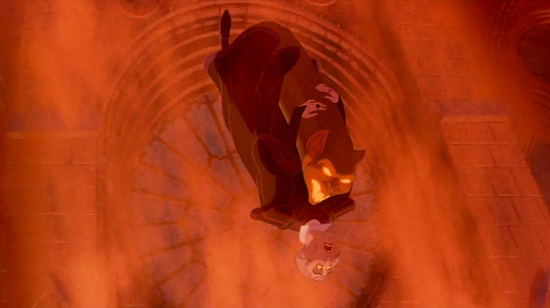
JUDGE FROLLO from THE HUNCHBACK OF NOTRE DAME (1996)
PLUNGED INTO THE FIERY PIT
There’s a complaint that Disney tends to kill most of their villains off in the same way, which is to have them fall from a great height, making it a bit of a cliché. The truth is that even though it does show up multiple times in Disney animation, it is an overall effective way to have the villain meet their end in a G-rated film; it’s bloodless and it doesn’t involve the heroes actively dealing a killing blow to the villain, thereby maintaining their purity of character. A lot of Disney villains meet their end this way; Gaston, Professor Ratigan, Mother Gothel. But it is perhaps Judge Claude Frollo’s fall from a high place that stands as the most memorable. Not only is he falling from the balcony of the Notre Dame cathedral, but he is plunged head first while grabbing onto a very heavy stone gargoyle sculpture towards the square down below, which we know from earlier in the film has been covered in a layer of molten iron that the hero Quasimodo poured down to ward off invaders. You’ve got to believe that it was not a pleasant end for Frollo. Frollo is far and away one of the most vividly portrayed evil characters in any Disney movie. His pious hypocrisy makes him an especially hateable presence in the film, and the fact that he’s a bit of a sadist is another layer to his villainy that makes him all the more potent. That’s why his death scene has this satisfying and ironic karmic sense to it. He believes he’s got the heroes, Quasimodo and the gypsy Esmeralda, cornered and he triumphantly holds his sword up high, quoting scripture by saying, “He shall smite the wicked and plunge them into the fiery pit.” But, of course fate has other plans, as Frollo’s footing gives way. Amping up the symbolism of the moment, the filmmakers had the gargoyle that Frollo is clinging to life to transform into a terrifying hell beast, indicating where Frollo is headed to in the next life. It’s operatic and perhaps a little too heavy-handed, but still a satisfyingly gruesome end to one of Disney’s most evil human monsters.
6.
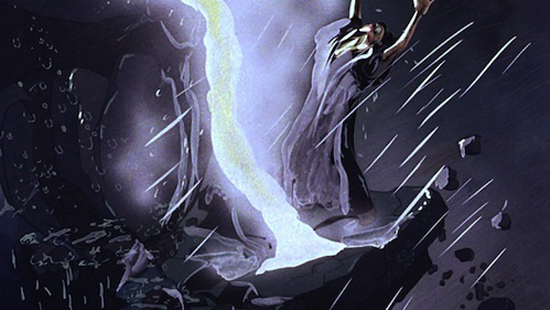
THE EVIL QUEEN from SNOW WHITE AND THE SEVEN DWARVES (1937)
STRUCK BY LIGHTNING, FALL OFF A CLIFF, AND CRUSHED BY A BOULDER
You wouldn’t think that Disney would take out their villain in a violent way during it’s early years, let alone in their first feature film ever, and yet they did just that. Snow White and the Seven Dwarves pushed the boundaries of what could be done with the animated medium, and it’s interesting that Disney did not hold back when it came to creating a terrifying presence in their villainous Evil Queen. Everything about the character is dark and foreboding, even during her regal scenes in her castle. Once she transforms into her peddler woman form, she is the stuff of nightmares, with her gnarled fingers and buggy eyes. As sweet and light as the rest of the film is, the Queen casts a dark shadow whenever she appears. It’s to Walt Disney and his team’s credit that they remained true to the dark nature of the character, and it’s likely why they also chose to make her comeuppance in the story all the grander once it comes. The moment Snow White bites the poison apple, it’s almost like nature itself has come apart, as the Queen’s triumphant laughter is punctuated by the sudden flash of a raging storm. As she makes her way back to her castle, she finds that the Seven Dwarves are hunting her down. She escapes them by climbing up a mountain slope, only to get cornered on a cliffside. A precariously balanced boulder nearby gives her one final weapon to stop the Dwarves, and she tries to push it down their way, hoping to crush them. In a real deus ex machina moment, her evil intent is stopped by a lightning strike right at her feet. It crumbles her ledge away, causing her to fall to her death (it all started here). To make the death even more gruesome, the boulder she intended to crush the dwarves with ends up toppling in her direction after she falls off screen with a final helpless scream. It is amazing that even in their first animated film they managed to make their climax feel this monumental, and the Evil Queen’s over-the-top death scene really set the bar high for Disney afterwards. It almost seemed like they were afraid to go as big as they did afterwards, because another Disney villain wouldn’t die on screen until Maleficent 22 year later. Nevertheless, it is one that still remains memorable over 80 years later and is still a somewhat shocking moment for a Disney movie given when it was made.
5.
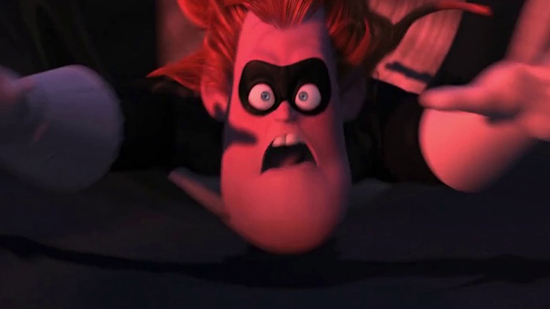
SYNDROME from THE INCREDIBLES (2004)
DEATH BY CAPE
Keeping in the same tradition of Hopper from A Bug’s Life, the main adversary of the Incredibles family also has a death scene that is both gruesome and hilarious at the same time. Earlier in the film, the Incredibles’ go-to outfit designer Edna Mode makes it clear that she has one primary rule: No Capes!! The reason for this is because though capes are an aesthetically pleasing and traditional part of a superhero’s overall presentation, it can also become a hazard depending on the situation. The movie demonstrates this with a hilarious montage of different super heroes over the years who have had their cape get snagged on something or causes their wearers to get pulled into harm like they were lassoed in by a rope. The Incredibles creator Brad Bird (who also voiced Edna Mode) brilliantly pays off this gag late in the film’s climax with the villain Syndrome being killed off by what else, his cape. The great thing about this pay off is how sneakily Brad Bird brings it back into the movie. Syndrome’s cape is not exactly a prominent feature of his costume, so we forget it’s there most of the time. But once Syndrome is thwarted after Mr. Incredible throws his car at the villain’s hover plane, he is thrown back towards one of the plane’s jet turbines, and all of a sudden we are acutely aware of the cape. It’s a hilarious way to finish off this villain, who certainly has earned this karmic death after the years of slaughtering super heroes to build better weaponry, but also at the same time when you think about it, it is also horrific in it’s own way. What happens to the human body when it gets sucked into a turbine engine is pretty gruesome. The movie spares us the blood and horror of it, instead showing the fireball aftermath, but we can still imagine what happened. Given the gruesome nature of it, as well as the perfect punchline to a running joke throughout the movie, this is certainly the best villain death to have come from Pixar Animation.
4.
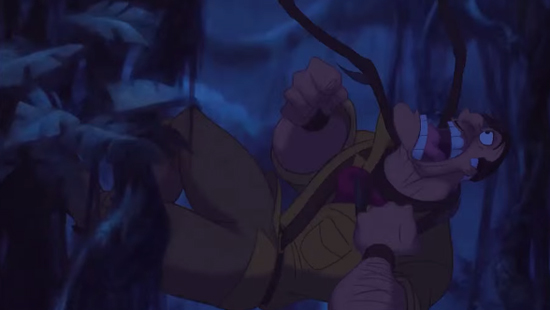
CLAYTON from TARZAN (1999)
HUNG EXECUTION STYLE IN TREE VINES
Tarzan is definitely one of Disney’s more action oriented films, so more on screen violence is to be expected. This also leads to one of the more explicitly violent villain deaths in all of Disney Animation. Clayton is not a particularly original villain. His kind of trigger happy gentleman explorer type is just basic stock villainy for a lot of films similar to this one, both in animation and live action. He still works as formidable foe for Tarzan in the movie, and is give a wonderfully boisterous vocal performance by legendary British character actor Brian Blessed. But during the film’s climatic confrontation, Disney shockingly pushes the limit for what they can get away with in a G-rated film with the way Clayton meets his demise. He chases Tarzan into the treetops with his shotgun fully loaded. Tarzan and him skirmish for a bit, before Tarzan manages to disarm him. Tarzan could end the fight by pulling the trigger, but he proves he’s the bigger man by not sinking to Clayton’s brutal level and he smashes the gun to pieces. Clayton then resorts to using his machete to lunge with murderous intent at Tarzan. The fight ends up culminating in a tangle of vines, which Tarzan has a natural advantage in. With his knowledge of the natural barrier that the vines provide, he manages to entangle his foe in the foliage. But, the still bloodthirsty Clayton tries to hack his way out, not knowing that one of the vines has roped around his neck. Tarzan tries to intervene, but Clayton cuts one vine to many and begins to fall. After a quick freefall, we see the last vine attached to Clayton go taut. We don’t see explicitly what happened, but a quick lightning flash shows the shadow of Clayton’s lifeless dangling body hanging off screen. This is one moment where Disney gets the closest to not leaving anything to the imagination, and it is a shockingly brutal end for the villain. It fits with the tone of Tarzan as a whole, which is among the more mature Disney animated movies, but even still compared to all the other Disney villain deaths, the fact that it is so grounded in reality makes the moment feel all the more shocking overall.
3.

URSULA from THE LITTLE MERMAID (1989)
IMPALED BY A SHIPWRECK
One of the most memorable Disney Villain divas should absolutely have a death scene as over-the-top as their personality. Ursula the Sea Witch gets hers through one of the craziest turn of events seen in any Disney film ever. After gaining her rival King Triton’s crown and trident, Ursula commands enormous power over the ocean. She enacts her malice by growing to giant size and creating a chaotic storm. Ariel the mermaid and the love of her life Prince Eric get swept into the maelstrom of Ursula’s creation, but the swirling water also dredges up ship wrecks from the ocean floor. Eric manages to climb aboard one of these wrecks that has reached the surface and using his seafaring skills, he manages to steer it in Ursula’s direction. Ursula is distracted by her focus on killing Ariel, and doesn’t see the ship making it’s way toward her, with the decayed bow having now become a nice pointy end. She only notices a half second before and the sharpened bow cuts right into her. The colossal Ursula has been completely impaled from front to back, and she quickly melts away as the life leaves her, leaving a smoky pool behind on the water’s surface. It’s been told by the filmmakers that Ursula’s confrontation with Ariel and Eric was more low key in early versions of the story, and it was actually Disney Animation chief at the time, Jeffrey Katzenberg, who told them to make the climax a lot bigger, saying in his words, “I need it to be more Die Hard.” And I guess they took it literally, because they made the climax bigger by making Ursula bigger. But, given the enormity of her personality to begin with, this climax just fits the character a lot better. In a strange way, this seems like the way Ursula would have wanted to go out; in spectacular fashion. And kudos on Disney for once actually not taking the safe route and minimizing the gory details. It’s a violent end, but one that is appropriate for this kind of classic villain.
2.

THE HORNED KING from THE BLACK CAULDRON (1985)
RIPPED APART BY THE POWER OF THE CAULDRON
Of all of the films made by Disney Animation, the darkest by design was their fantasy epic The Black Cauldron. Made at a time when Disney was desperately trying to re-invent themselves in what was known as their Dark Age, The Black Cauldron was a far more violent and adult-oriented movie. It was also the first time Disney received a PG Rating. The shift in tone didn’t work out, as the movie was a financial flop that almost killed the animation department at the studio. But, there have been elements about the movie that have helped it to gain a cult fanbase over the years. One of them is the very memorable villain, The Horned King. The Skeletal faced adversary is far and away one of the most terrifying characters to ever appear in a Disney animated film, or any animated film for that matter. And of course, with a villain this terrifying and with so many evil deeds done in his wake, the comeuppance that he faces in the climax has to be as fittingly as gruesome as he is. Given that The Black Cauldron was made in a moment in time when Disney felt unencumbered by the need to keep things family friendly, they decided that the Horned King’s death had to be a shocking one, and boy did they deliver. Once the spell he has casted on the Cauldron begins to reverse itself, all of the magic begins to return back to the cauldron in a powerful black hole like vortex. The Horned King tries to evade the pull of the Cauldron, but it overpowers him. He makes one final desperate cling to life at the Cauldron’s rim, but the force begins to peel the skin off of the King’s bones. The Horned King is violently torn apart piece by piece as the Cauldron consumes his essence and he is finally obliterated in one final violent explosion. I don’t think you’ll find a more visibly gruesome villain death in any other animated Disney movie. The Black Cauldron wasn’t afraid to take it’s story into violent places and show it all on screen, and that was evident by the visually explicit way that the Horned King meets his end.
1.

JUDGE DOOM from WHO FRAMED ROGER RABBIT? (1988)
MELTED BY DIP
Sure this is not a canonical Disney Animated movie, but the Disney Animation studio did work on this and Judge Doom is technically a cartoon character, so that makes this a Disney Villain death. And the reason why he has managed to top this list is because I don’t think any other Disney Villain has had their life ended in a more gruesome and violent way than how Judge Doom meets his end. The main villain of Who Framed Roger Rabbit? is definitely one of the most terrifying characters ever put on screen (played brilliantly by Christopher Lloyd) and that’s true even before we see his final form. At one point with his climatic battle with the heroic Eddie Valiant, Doom appears to have met his end under the crushing power of a cement roller. But, we soon learn that he was a cartoon the whole time, wearing a rubber mask disguise to appear human. When he regains his shape, we see the terrifying red eyes now poking through the mask, creating a sight that drove terror into this writer as a child every time. But, much like other villains on this list, Judge Doom falls victim to his own hubris, and is killed off by his own invention. Doom had created a liquid mixture of Turpentine, Acetone and Benzine (all paint removers) to melt cartoon characters out of existence. His master plan was to destroy all of Toontown (home of all the cartoon characters) with the nasty mixture, but Valiant manages to turn the tables of the maniacal judge and causes a spill of the substance to shoot out in Doom’s direction. Judge Doom slowly melts down into the green colored pool, all the while screaming “I’m melting” in a nod to the Wicked Witch’s similar fate. You really get the sense that Judge Doom went out painfully in the end, and it’s fitting given the sadistic way that he put a cute little cartoon shoe through the same fate earlier in the film. Even as much as he deserved what came to him, there is this incredible sense of grimness in seeing a character just melt away into nothing, especially knowing just how painful each second of it would have been. That’s why Judge Doom’s death scene is the darkest and most gruesome that Disney has ever put on screen.
Disney certainly doesn’t go dark and violent often, but as we’ve seen in some of the cases above, that when they do they make it memorably visceral and even sometimes graphic. Of course, some of the most memorably evil baddies get grandiose exits, like Maleficent and Ursula. But, at times Disney may even throw in a shockingly violent end to even a lesser villain. The example of Clayton in Tarzan shows how they’re not afraid to give a vividly violent death to a more grounded character who left a lesser impact. And there are of course the examples of the Horned King and Judge Doom, where Disney made use of the added freedom of a PG rating to show a bit more violence on screen. Whatever the case, there definitely are rules that Disney still sticks with when it comes to how they give their villains a comeuppance that either leaves them dead or not. For one thing, I notice that when a villain dies in a Disney movie, it’s mainly because they had already taken a life beforehand, and ending up dead themselves is just karmic retribution. That’s definitely the case with on screen murders committed, like with Judge Doom, Scar, Frollo, Hopper, Clayton and the Evil Queen, or those implied off screen like with Maleficent, Ursula, the Horned King, and Syndrome. Another rule that Disney applies is that their heroes can’t kill their villains unless it is a last act necessity. That’s why so many villains meet their end through their own hubristic mistakes in Disney films, hence why a fall from a high place is so commonly used. It’s always interesting to see Disney take more creative routes in dealing with their villainous characters, even when it means showing them mercy in the end. Not every villain needs to meet a terrible fate, and as much as people like to see a big violent end for these characters, the movie doesn’t need it always to have a satisfying conclusion to a story. For this list, it does offer up some interesting insights into how a company like Disney tends to handle darker moments within their movies, and it shows that they can go surprisingly hard when it comes to giving their Villains a violent and gruesome death. They were even capable of doing so even in Walt’s time, with the Evil Queen’s three fold comeuppance in Snow White. For this spooky time of year, I hope this was an interesting look into the different times Disney took a risk and gave their Villains a really hardcore exit out of their movies; even to some very shocking levels.

